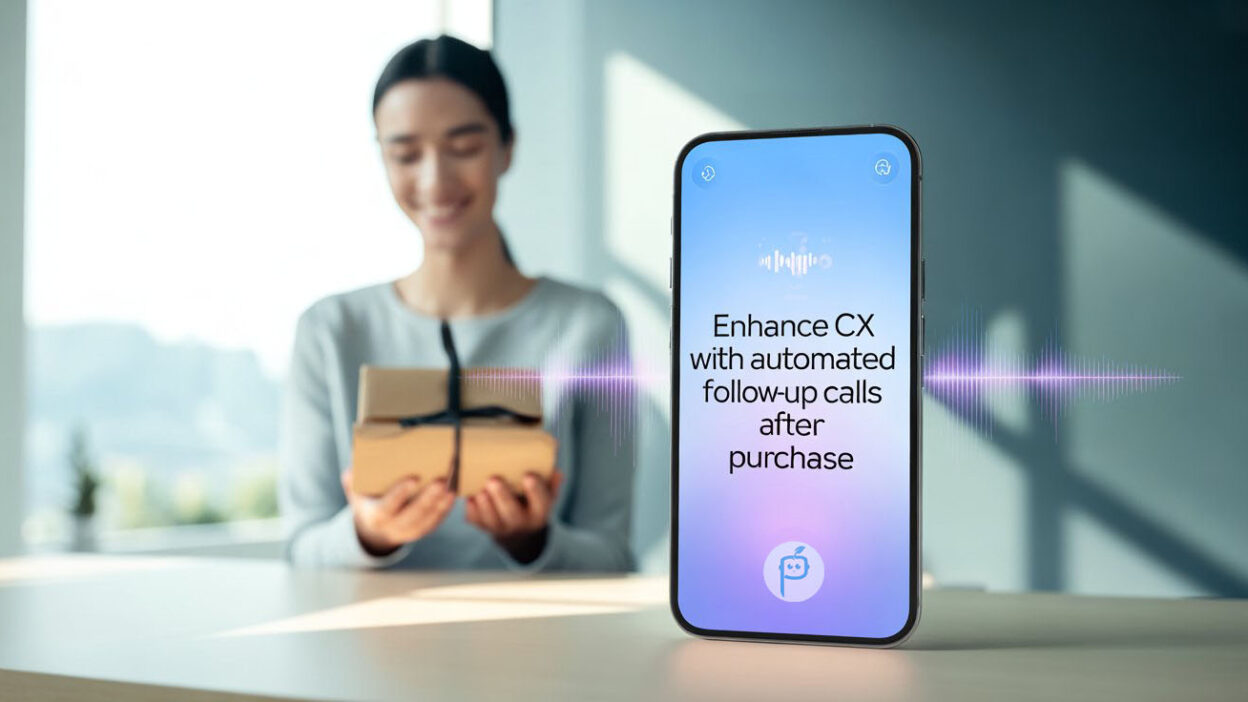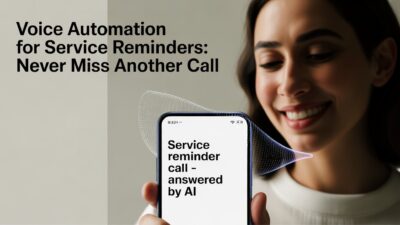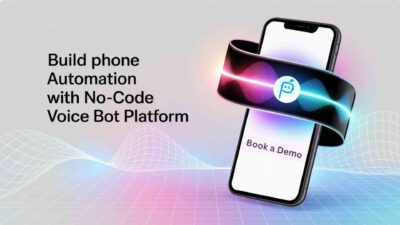Automated follow-up calls after purchase bridge this expectation gap perfectly. Customer experience defines business success in today’s competitive market. Every interaction matters. Every touchpoint shapes perception. Companies that excel understand this fundamental truth.
Table of Contents
Purchase completion marks the beginning, not the end, of customer relationships. What happens next determines loyalty. It influences repeat purchases. It drives word-of-mouth recommendations.
Why Automated Follow-up Calls After Purchase Matter
Modern customers expect seamless experiences. They want businesses to care beyond the transaction. These calls show genuine interest in customer satisfaction. They demonstrate commitment to service excellence. They create opportunities for deeper engagement.
Statistics reveal compelling evidence. Companies using follow-up call solutions see 23% higher customer retention rates. They experience 18% more positive reviews. They generate 15% increased repeat sales.
The personal touch matters immensely. Customers appreciate businesses that check on their experience. They value companies that proactively address concerns. They trust brands that maintain consistent communication.
Benefits of Implementing Automated Follow-up Calls After Purchase
Enhanced Customer Satisfaction
Follow-up call solutions create immediate value for customers. They reassure, support, and show you care.
Customers feel valued when businesses reach out proactively. This feeling translates into positive emotions toward the brand. It builds emotional connections that transcend price considerations.
Improved Problem Resolution For Automated Follow-up Calls After Purchase
Issues often emerge after purchases are complete. Customers may struggle with product setup. They might have questions about usage. They could experience delivery problems.
Follow-up call solutions catch these issues early. Early detection prevents small problems from becoming major complaints. It reduces negative review risks significantly.
Quick problem resolution builds trust. It shows responsiveness. It demonstrates commitment to customer success.
Increased Sales Opportunities For Automated Follow-up Calls After Purchase
Follow-up calls create natural upselling moments. Satisfied customers are more receptive to additional offers. They trust businesses that have already delivered value.
Follow-up call solutions can identify expansion opportunities. They reveal additional customer needs. They uncover complementary product interests.
Cross-selling becomes easier when customers feel cared for. They view recommendations as helpful suggestions rather than pushy sales tactics.
Valuable Feedback Collection For Automated Follow-up Calls After Purchase
Customer feedback drives business improvement. Direct feedback is especially valuable. It provides unfiltered insights into customer experiences.
Conversational AI for follow-ups facilitate natural feedback collection. Customers share honest opinions during these conversations. They highlight pain points and positive experiences.
This feedback informs product development. It guides service improvements. It shapes future customer experience strategies.
Best Practices for Automated Follow-up Calls After Purchase
Timing Is Everything In Case Of Automated Follow-up Calls After Purchase
The timing of automated follow-up calls after purchase impacts their effectiveness. Too early, and customers haven’t had enough experience. Too late, and the moment has passed.
Most successful implementations schedule calls 3-7 days after purchase delivery. This timeframe allows customers to experience the product. It ensures issues have had time to surface.
For service purchases, calls should occur 24-48 hours after completion. This timing captures immediate impressions. It addresses any lingering concerns promptly.
Personalization Enhances Impact For Automated Follow-up Calls After Purchase
Generic scripts kill the personal touch. Customers recognize canned responses immediately. They appreciate calls that reference specific purchase details.
Automated follow-up calls after purchase should mention the exact product purchased. They should reference the purchase date. They should acknowledge any special circumstances or requests.
Personalization extends beyond basic details. It involves understanding customer preferences, recognizing purchase history patterns, and adapting communication styles.
Train Your Team Properly
Automation doesn’t eliminate the human element. Real people make these calls. Their training determines success or failure.
Staff making automated follow-up calls after purchase need specific skills. They must balance script adherence with natural conversation. They should handle unexpected situations gracefully.
Training should cover active listening techniques. It should emphasize empathy development. It should prepare representatives for various customer responses.
Technology Integration Matters
Effective automated follow-up calls after purchase require robust technology infrastructure. CRM systems must trigger calls automatically. They should provide representatives with complete customer information.
Integration with purchase systems ensures accurate data. It prevents embarrassing mistakes. It enables smooth conversation flow.
Technology should capture call outcomes. It should track customer responses. It should measure satisfaction levels consistently.
Implementing Automated Follow-up Calls After Purchase
Phase One: Planning and Preparation
Successful implementation begins with thorough planning. Define clear objectives for your automated follow-up calls after purchase program. Identify key metrics for measuring success.
Analyze your customer base carefully. Different customer segments may require different approaches. B2B customers prefer different timing.
Develop scripts that sound natural and conversational. Test them with internal teams first. Refine them based on feedback and practice sessions.
Phase Two: Technology Setup
Choose technology platforms that integrate with existing systems. Ensure they can handle your call volumes efficiently. Verify they provide necessary reporting capabilities.
Set up automatic triggers based on purchase events. Configure customer data synchronization. Test all integrations.
Create backup procedures for technology failures. Ensure manual processes can maintain service continuity. Plan for system maintenance and updates.
Phase Three: Staff Training and Launch
Train selected staff members on new procedures. Practice various scenarios they might encounter. Role-play difficult customer interactions.
Start with a small pilot group of customers. Monitor initial results carefully. Gather feedback from customers and staff.
Adjust procedures based on pilot feedback. Refine scripts and timing as needed. Gradually expand to full customer base.
Phase Four: Monitoring and Optimization
Track key performance indicators consistently. Monitor customer satisfaction scores. Measure impact on retention and repeat purchases.
Automated follow-up calls after purchase should evolve continuously. Regular analysis reveals improvement opportunities. Customer feedback guides optimization efforts.
Review call recordings periodically. Identify common issues or concerns. Use insights to improve products and services.
Measuring Success of Automated Follow-up Calls After Purchase
Key Performance Indicators
Customer satisfaction scores provide primary success indicators. Compare scores before and after. Implement automated follow-up calls after purchase. Look for significant improvements over time.
Customer retention rates reveal long-term impact. Track how many customers make repeat purchases. Monitor the time between purchases for returning customers.
Revenue per customer often increases with effective follow-up programs. Calculate average order values over time. Measure total customer lifetime value improvements.
Customer Feedback Analysis
Direct customer feedback offers valuable insights. Analyze comments from follow-up calls systematically. Identify recurring themes and suggestions.
Online reviews often mention follow-up experiences. Monitor review platforms for feedback about your automated follow-up calls after purchase. Address any negative patterns quickly.
Survey responses provide quantitative data. Send brief surveys after follow-up calls. Ask specific questions about call value and satisfaction.
Operational Metrics
Call completion rates indicate program effectiveness. Track how many scheduled calls connect with customers. Identify patterns in unsuccessful attempts.
Average call duration provides efficiency insights. Very short calls might indicate disengaged customers. Very long calls could suggest training needs.
Issue resolution rates demonstrate program value. Track how many customer problems get resolved through follow-up calls. Monitor resolution timeframes.
Common Challenges and Solutions
Customer Availability Issues
Reaching customers can be challenging. People have busy schedules. They might not answer unknown numbers.
Multiple contact attempts often succeed where single calls fail. Automated follow-up calls after purchase systems should retry at different times. They should try different days of the week.
Providing multiple contact options improves success rates. Offer email follow-ups as alternatives. Allow customers to schedule convenient call times.
Script Authenticity Concerns
Customers can detect overly scripted conversations. They prefer natural, conversational interactions. Finding the right balance requires careful attention.
Train representatives to use scripts as guides, not rigid requirements. Encourage natural conversation flow. Allow flexibility for different customer personalities.
Regular script updates keep conversations fresh. Incorporate new insights and feedback. Remove phrases that sound artificial or outdated.
Technology Reliability
System failures can disrupt automated follow-up calls after purchase programs. Backup procedures ensure continuity. Regular maintenance prevents most issues.
Choose reliable technology providers with strong support records. Ensure they provide adequate uptime guarantees. Plan for scalability as programs grow.
Future Trends in Automated Follow-up Calls After Purchase
Artificial Intelligence Integration
AI technology is transforming customer communication. Smart systems can analyze customer sentiment. They can suggest responses to representatives in real-time.
Predictive analytics help optimize call timing. AI can identify the best times to reach individual customers. It can personalize approach strategies automatically.
Omnichannel Integration
Future follow-up call solutions will integrate with other communication channels seamlessly. Customers might start conversations via phone and continue through chat or email.
Unified customer profiles will span all touchpoints. Representatives will have complete interaction histories. This enables more personalized and effective conversations.
Enhanced Personalization
Advanced data analytics enable deeper personalization. Future systems will understand individual customer preferences better. They will adapt their communication styles automatically.
Behavioral analysis will inform follow-up strategies. Systems will recognize patterns in customer responses. They will optimize approaches for different personality types.
Read More: Conversational AI Outbound Calls: Best Practices & Results
Conclusion
Post-purchase follow-up system represent a powerful tool for enhancing customer experience. They demonstrate care beyond the transaction. They create opportunities for deeper customer relationships.
Success requires careful planning and execution. Technology must integrate seamlessly with existing systems. Staff need proper training and ongoing support.
The benefits justify the investment. Improved customer satisfaction leads to increased loyalty. Better retention drives sustainable business growth.
Companies that implement post-purchase follow-up system gain competitive advantages. They build stronger customer relationships. They create foundations for long-term success.
Start planning your program today. Your customers will appreciate the extra attention. Your business will benefit from stronger customer connections.





